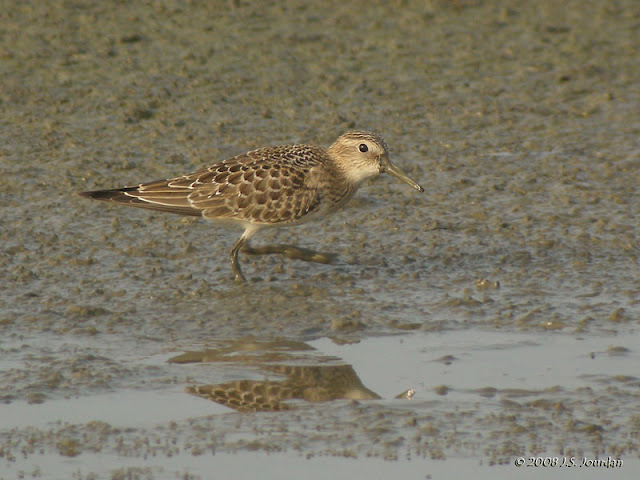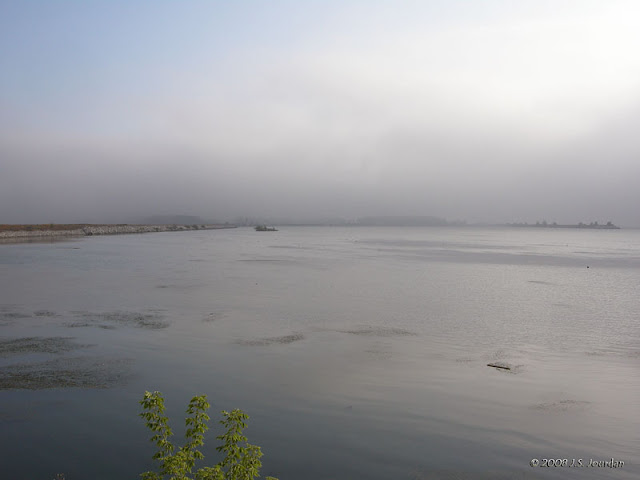Lucky to be Alive! - 30 Aug 2008
This juvenile Green Heron is looking a bit haggard. I digiscoped it from the dike overlooking the east end of the Vermet Unit just moments after it was attacked by a juvenile Peregrine Falcon. But more on this below...
This would be my last chance to bird Pt. Mouillee before the hunting season that starts Sept. 1, so I grabbed the bike and gear and headed down to the parking lot at Mouillee Creek. Forecast for today was sun and high 80's, but at 7am a light fog blanketed the marsh. The rising sun glowed crimson red, so I took a photo through the 400mm f/5.6 Sigma.
As I approached the Walpatich Unit a Green Heron flushed from the near bank and flew off into the mist. A second bird remained perched on a dead snag and allowed several portraits to be taken in the early morning light.
Reaching the junction of Middle Causeway, Long Pond and Vermet Units I came upon a small flock of shorebirds feeding in the shallow waters of the Lead Unit. Most of the birds were Lesser and Greater Yellowlegs, but several Short-billed Dowitchers and Semipalmated Sandpipers fed among them.
I found this cooperative Stilt Sandpiper feeding close to the near shore and got several keeper digiscoped images.
Matt Yawney was returning from the Banana Unit and pointed out a Black-bellied Plover just a few yards away.
Small flocks of Blue-winged Teal were a bit farther out but still within photographing range.
As I digiscoped the shorebirds I kept hearing Sora calling from the cattails out in the Lead Unit. As I scanned the base of the cattails I saw a Marsh Wren hopping from stubble to stubble, but couldn't get any pics through the scope. After several minutes of scanning the emergents I finally spotted a Sora wandering out into the open. Tracking the bird through the camera and scope I finally managed a capture.
Will Weber arrived and reported that he had seen a Red Knot and numerous other shorebirds in the Walpatich Unit. As we headed eastward on the Middle Causeway we stopped to check out a small flock of Caspian and Forster's Terns on the sandspit in the Vermet Unit, and a pair of Osprey on the platform in the Lead Unit.
Stopping at Cell 3 we ran into Adam Byrne and Caleb Putnam, who pointed out the Buff-breasted Sandpiper that just appeared in the middle of the mud flats in front of us. As they drove off I digiscoped the Buff-breasted Sandpiper as it fed and preened about 90 feet away. I even took a short video of it as it preened.
Closer to the near bank a juvenile Baird's Sandpiper fed alongside several Semipalmated Sandpipers.
Looking out over Cell 4 we watched as a fog bank moved in,
so we rode over to the dike along the east side of Cell 3 and scoped several Stilt Sandpipers and Short-billed Dowitchers. A Ruddy Turnstone was feeding nearby, but the now-dense fog prevented any digiscoping. A Lesser Yellowlegs flew in out of the mist and came in for a landing near the shore's edge, and I grabbed a sequence as it landed. I was pleased how its reflection bounced off the near-still water below its feet.
Slightly closer, a Semipalmated Sandpiper (juvenile) posed nicely and even provided views of its slightly-webbed feet.
Leaving Cell 3 we ran into Don and Robyn Henise and said hello (they would later report a Western Sandpiper in the same vicinity as we were....). As the Middle Causeway approached we decided to continue on toward the North Causeway and check out the Vermet and Long Pond Units. I'm so glad we did! Reaching the wooded expanse of the southern half of Cell 5 we spotted several fall warblers: Black-throated Green, American Redstart, and Magnolia. Adam and Caleb pulled up and joined us as we sifted through the severely back-lit birds for any additional surprises.
The real surprise came, however, from up the dike as we watched a juvenile Peregrine Falcon take off from the trees and head for the shallow waters of the Vermet Unit.
A lone Green Heron appeared to be its target, and for the next several minutes watched as the falcon swooped in and take swipes at the helpless heron. Its only escape was downward; as the falcon attacked, the heron would flatten its wings over the water and duck its head below. I fired away at 8fps with the D300 and Sigma 400/f5.6 and managed to record a sequence of shots from quite a distance. These cropped images show the falcon dive-bombing the hapless green heron.
After several attempts the Peregrine flew into a dead snag next to the dike ahead of us, and I approached it slowly, taking pics from a distance, and moving forward quietly a few steps at a time. I was able to get within about 20 feet of it and make out a pair of leg bands: A Black Band on the left tarsus that read "83X" and a Silver Band on the right tarsus. This bird is NOT the same one I photographed just 2 days earlier (which had a black over green on the left leg and a red band on the right leg)!
After several minutes rest it took off to the east. Just as it cleared the trees it was met by a Red-tailed Hawk that flew into the vicinity.
As the two birds circled away at each other I grabbed a few shots of the Red-tail. The Peregrine made a low pass directly overhead and I grabbed a few more flight shots in the back-lit skies. It then landed in the trees near where Will and Adam were located. Walking back I grabbed the scope and took a few digiscoped shots of the bird before moving on. We then passed the lucky Green Heron, and I grabbed a few digiscoped images from the top of the dike.
Just as we reached the junction of Vermet and Long Pond Units along the North Causeway Will spotted a group of shorebirds along the shoreline. Among them were 3 Baird's Sandpipers, and I managed a few flight shots as they flew off. It was at this time that we split up and I headed back to the car.
A great way to end the Pt. Mouillee birding season. Still, it'll be tough not being able to go back until January....
Pte. Mouillee SGA (permit required Sep 1-Dec 15), Monroe, Michigan, US
Aug 30, 2008 7:00 AM - 10:30 AM
Protocol: Traveling
7.0 mile(s)
Checklist Comments: This would be my last chance to bird Pt. Mouillee before the hunting season that starts Sept. 1, so I grabbed the bike and gear and headed down to the parking lot at Mouillee Creek. Forecast for today was sun and high 80's, but at 7am a light fog blanketed the marsh.
21 species
Blue-winged Teal (Spatula discors) 6
Sora (Porzana carolina) 1
Black-bellied Plover (Pluvialis squatarola) 1
Short-billed Dowitcher (Limnodromus griseus) 3
Lesser Yellowlegs (Tringa flavipes) 3
Greater Yellowlegs (Tringa melanoleuca) 3
Ruddy Turnstone (Arenaria interpres) 1
Stilt Sandpiper (Calidris himantopus) 4
Buff-breasted Sandpiper (Calidris subruficollis) 1
Baird's Sandpiper (Calidris bairdii) 4 juvenile; note white fringes and Buffy necklace.
Semipalmated Sandpiper (Calidris pusilla) 3
Caspian Tern (Hydroprogne caspia) 6
Forster's Tern (Sterna forsteri) 6
Green Heron (Butorides virescens) 3 after being attacked by peregrine falcon
Osprey (Pandion haliaetus) 2
Red-tailed Hawk (Buteo jamaicensis) 1
Peregrine Falcon (Falco peregrinus) 1 composite of bird taking off after Green Heron
Marsh Wren (Cistothorus palustris) 1
American Redstart (Setophaga ruticilla) 1
Magnolia Warbler (Setophaga magnolia) 1
Black-throated Green Warbler (Setophaga virens) 1
View this checklist online at https://ebird.org/checklist/S4
This report was generated automatically by eBird v3 (https://ebird.org/home)
Aug 30, 2008 7:00 AM - 10:30 AM
Protocol: Traveling
7.0 mile(s)
Checklist Comments: This would be my last chance to bird Pt. Mouillee before the hunting season that starts Sept. 1, so I grabbed the bike and gear and headed down to the parking lot at Mouillee Creek. Forecast for today was sun and high 80's, but at 7am a light fog blanketed the marsh.
21 species
Blue-winged Teal (Spatula discors) 6
Sora (Porzana carolina) 1
Black-bellied Plover (Pluvialis squatarola) 1
Short-billed Dowitcher (Limnodromus griseus) 3
Lesser Yellowlegs (Tringa flavipes) 3
Greater Yellowlegs (Tringa melanoleuca) 3
Ruddy Turnstone (Arenaria interpres) 1
Stilt Sandpiper (Calidris himantopus) 4
Buff-breasted Sandpiper (Calidris subruficollis) 1
Baird's Sandpiper (Calidris bairdii) 4 juvenile; note white fringes and Buffy necklace.
Semipalmated Sandpiper (Calidris pusilla) 3
Caspian Tern (Hydroprogne caspia) 6
Forster's Tern (Sterna forsteri) 6
Green Heron (Butorides virescens) 3 after being attacked by peregrine falcon
Osprey (Pandion haliaetus) 2
Red-tailed Hawk (Buteo jamaicensis) 1
Peregrine Falcon (Falco peregrinus) 1 composite of bird taking off after Green Heron
Marsh Wren (Cistothorus palustris) 1
American Redstart (Setophaga ruticilla) 1
Magnolia Warbler (Setophaga magnolia) 1
Black-throated Green Warbler (Setophaga virens) 1
View this checklist online at https://ebird.org/checklist/S4
This report was generated automatically by eBird v3 (https://ebird.org/home)






























































Comments
Post a Comment
Please leave a comment. I will try to respond ASAP.